In an era where communication has become extremely simple, in Japan, the habit of sending Nengajō (年賀状) is still maintained every New Year..
Nengajō are more than just New Year’s greetings, their thoughtfulness and tangibility help people feel closer and more connected to each other.
As a foreigner living in Japan, you may wonder:
“Who can I write Nengajō to?”
“How to write Nengajō?”
“When do I need to send Nengajō to ensure the other party receives it on January 1?”
In this article, I will provide detailed information about the suitable recipients for sending Nengajō, as well as the process of writing and sending them to help you prepare a perfect Nengajō card.
Who should I send Nengajō to?
Nengajō can be sent to anyone you like
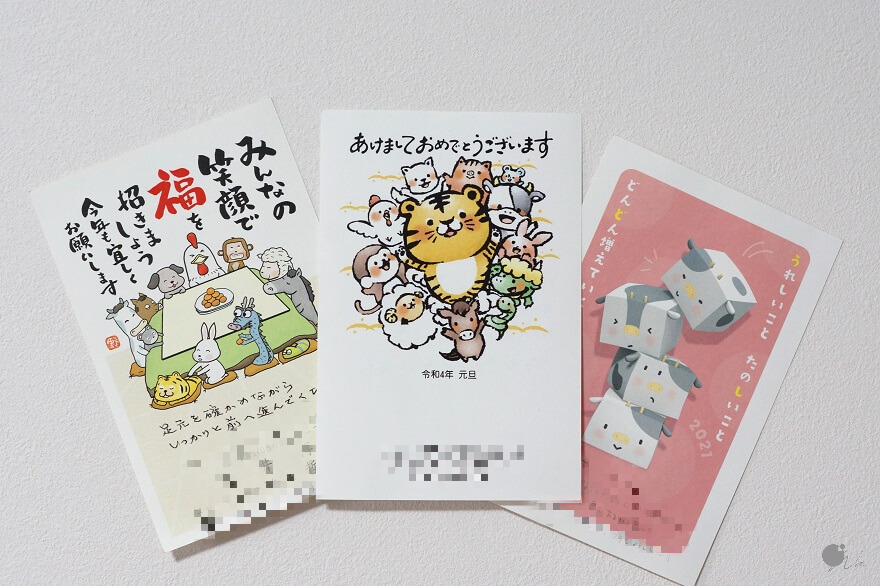
You can send Nengajō to anyone you like and want to maintain a long-term relationship with.
It could be distant relatives, people who always help you in life, close friends, colleagues or customers at work…
Note that once you send Nengajō to someone, in principle you need to keep sending it to that person throughout the following years.
It is considered very rude in Japan to stop sending Nengajō without warning, so you should be selective and only send to people you really want to connect with.
In case you want to stop sending Nengajō, please refer to the content “How to handle when you want to stop sending Nengajō ” at the end of the article.
Respond early when receiving Nengajō
On January 1st, check your mailbox to see if you’ve received a Nengajō from someone to whom you haven’t sent a Nengajō.
If you have, quickly retrieve your spare Nengajō and respond promptly to the sender.
According to custom in Japan, Nengajō needs to reach the recipient by January 7, so you need to send Nengajō a response before January 5.
Afterward, save the sender’s information in your contacts for easy sending of Nengajō in the following year.
Certainly, if you feel you cannot maintain sending Nengajō, it’s also acceptable to inform them.
Do not send Nengajō to someone who has been bereaved in the past year
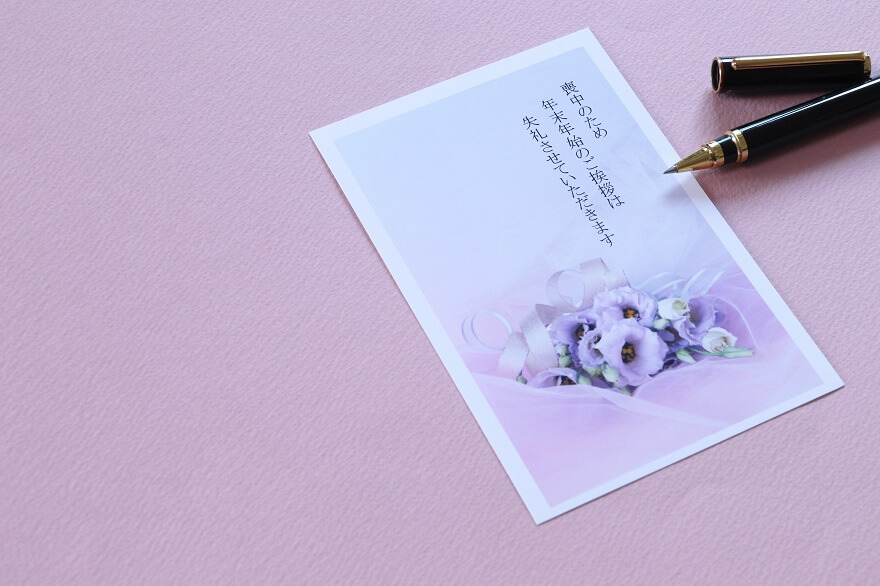
Note that you should not send Nengajō to people who have had a bereavement in the family in the past year.
So how do you know if your acquaintance is in mourning or not to avoid it?
Don’t worry, because they will notify you through a postcard called Mochū Hagaki (喪中はがき).
In case Mochū Hagaki arrives after you have sent Nengajō, quickly call your acquaintance to apologize and send your condolences.
How to write Nengajō
Basically, the front of the Nengajō will be write the information of the recipient and the sender, and the back of the Nengajō will be write the greetings.
How to write the front of Nengajō
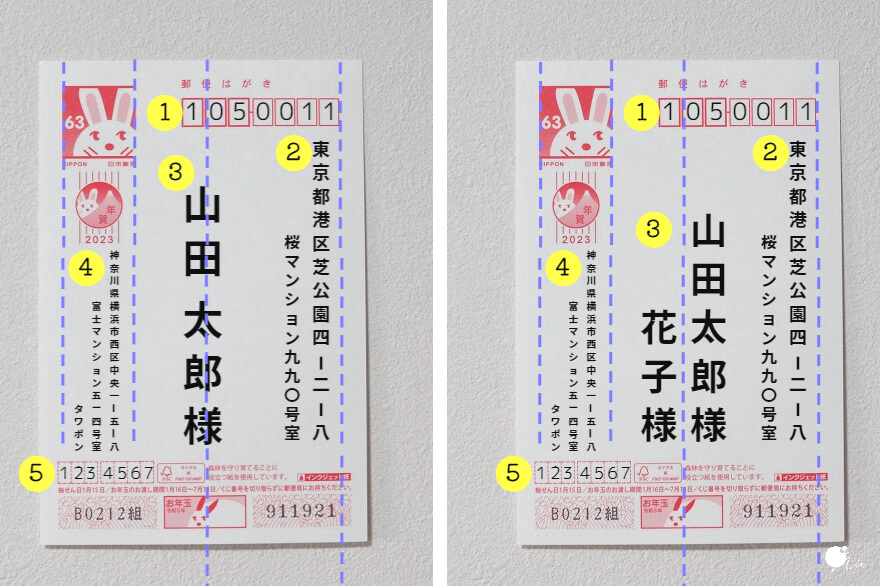
There are 5 pieces of information you need to write on the front of the Nengajō.
1. Recipient’s postal code
- Write horizontally
- Write in normal numbers
2. Recipient address
- Write vertically
- Do not write close to the edge of the paper, but keep a distance
- Write in full, do not omit the province name
- Số ghi bằng chữ Hán
Ví dụ:- Shibakōen 4-2-8: 芝公園四ー二ー八
- Room 990: 九九〇号室
※ The hyphen in the address must also be written vertically to avoid confusion with the number 1 (一) in Kanji.
3. Recipient name
- Write vertically
- Write in large letters right in the middle of Nengajō
- Write the representative’s name below the last name and write the names of other family members in the same size on the left
- If the recipient’s family is large, you can write「ご家族御一同様」(meaning: “And family”) next to the representative’s name.
4. Sender’s address and name
- Write vertically
- Write in small letters, the entire content should preferably fit within the width of the stamp
- Số ghi bằng chữ Hán
Ví dụ:- Chūō 1-5-8: 中央一ー五ー八
- Room 514: 五一四号室
※ The hyphen in the address must also be written vertically to avoid confusion with the number 1 (一) in Kanji.
5. Sender’s postal code
- Write horizontally
- Write in normal numbers
How to write the back of Nengajō
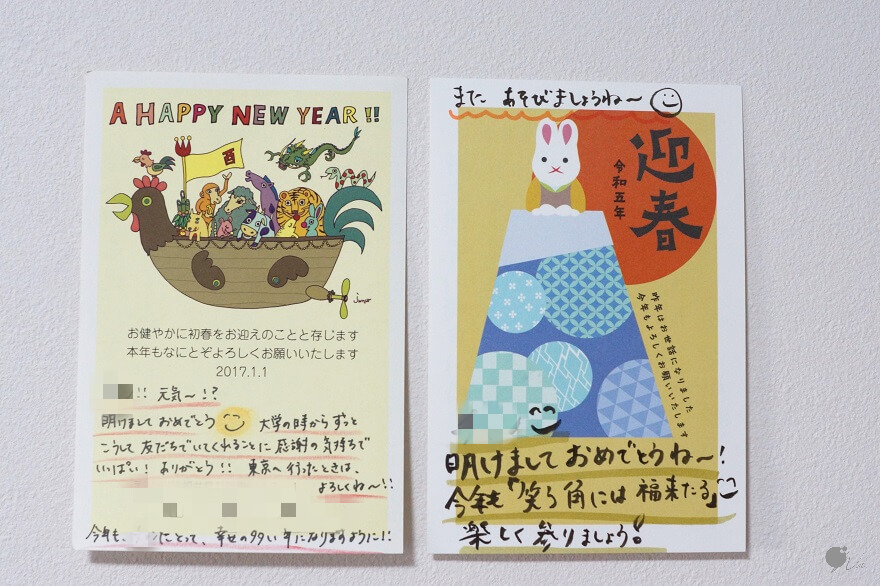
The back of the Nengajō already has a greeting written on it, so it’s okay if you don’t write anything else. However, if possible, write a few more words to make the recipient feel warmer.
Below are some simple New Year greetings in Japanese that can be used in many situations:
明けましておめでとうございます
今年もどうぞよろしくお願いいたします
(Meaning: Happy New Year. Thank you for your continued support this year.)
幸多き一年となりますように
(Meaning: Wishing you a prosperous year)
素敵な一年になりますように
(Meaning: I hope you have a wonderful year)
皆様のご健康とご多幸を心からお祈りいたします
本年もどうぞよろしくお願い申し上げます
(Meaning: I sincerely wish you all good health and happiness. Thank you for your continued support this year.)
すばらしい一年になりますよう心からお祈り申し上げます
本年もどうぞよろしくお願いいたします
(Meaning: I sincerely wish you a wonderful year. Thank you for your continued support this year.)
昨年中はいろいろとお世話になり心よりお礼申し上げます
今年もどうぞよろしくお願いいたします
(Meaning: Thank you very much for all your help over the last year. I look forward to your continued support this year.)
※ Note: Do not write the punctuation mark「。」because this mark represents the end or division and is not suitable for New Year’s cards.
How to send Nengajō
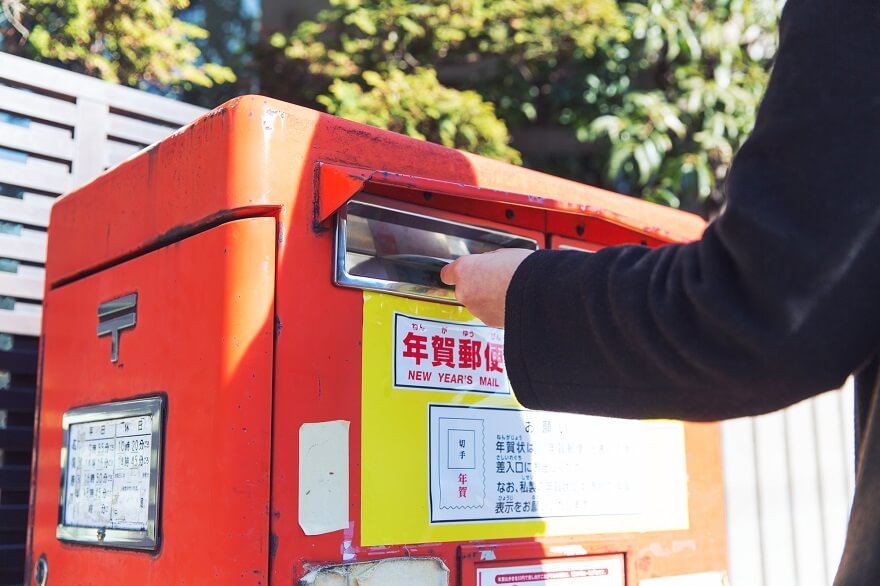
How to send
You can send Nengajō by submitting it directly to the post office or putting Nengajō in any mailbox you come across on the street.
When putting Nengajō in the mailbox, put it in the Nenga Yūbin (年賀郵便) slot to make sorting Nengajō faster and more accurate.
Sending time
The post office accepts Nengajō from December 15th to January 5th every year.
| Sending time | Receiving time |
|---|---|
| Before December 14 | In year |
| December 15 ~ December 25 | January 1 |
| December 26 ~ December 28 | January 3 |
| December 29 ~ January 5 | The latest is January 7 |
According to Japanese custom, Nengajō needs to reach the recipient before January 7.
If this cannot be guaranteed, replace Nengajō with Kanchū-mimai (寒中見舞い, cold season greeting card) and send it to the other person before February 4.
Kanchū-mimai will be sold at post offices and convenience stores after New Year so you can easily find and buy it.
Sending fee
If Nengajō is sold at a post office or convenience store, the purchase price includes shipping fees, so you do not need to pay any additional fees.
If it’s a homemade Nengajō, you’ll need to affix a 63 yen price stamp before sending it.
In case you want to send Nengajō abroad, you need to add a 37 yen stamp.
Where to buy Nengajō and how much does it cost?
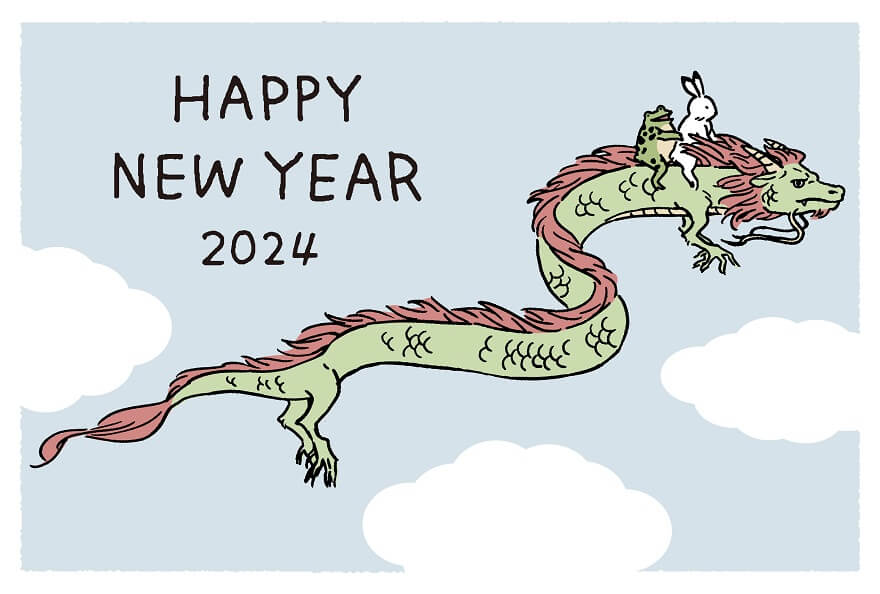
Nengajō can be easily purchased at post offices or convenience stores from early November.
Each Nengajō costs about 100 yen ~ 200 yen depending on the paper material and cuteness.
There are hundreds of different designs to choose from, most of which will feature Eto (干支) – the zodiac animal for the coming year. For example, 2024 is the year of the Dragon, so Nengajō will be filled with images of flying Dragons.
You can also make your own Nengajō using free websites.
However, sending homemade Nengajō is a bit more complicated. Specifically, you need to note the following:
- Dimensions: horizontal 90mm~107mm, vertical 140mm~154mm
- Weight: 2g~6g
- Needs 63 yen stamp
- Write「年賀」in red pen right below the stamp
- Write “POSTCARD” on the front of Nengajō in letters large enough for postal staff to recognize
Some other interesting information about Nengajō
Participate in the Nengajō lottery
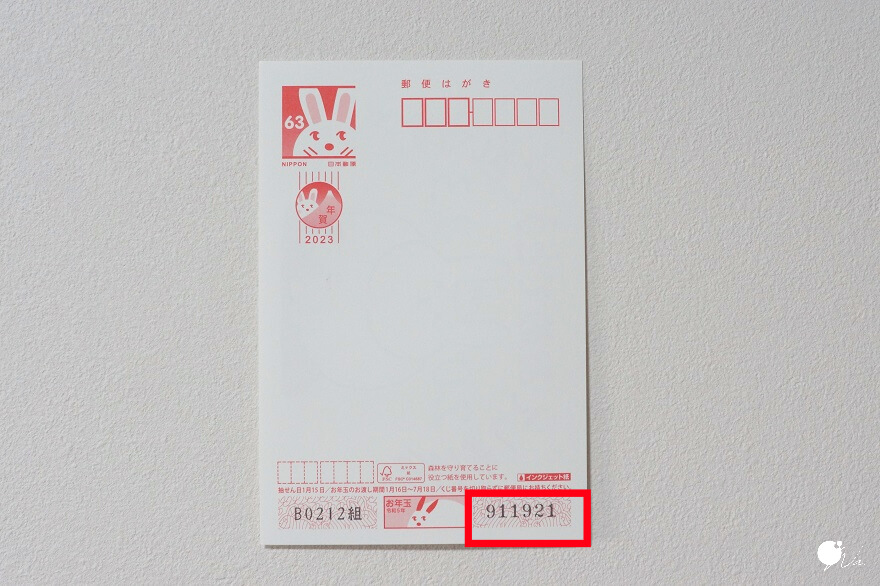
If the Nengajō you receive has a sequence of 6 numbers in the lower right corner, it is a sign that you have a chance to participate in the Nengajō lottery game.
The winning results will be announced by Japan Post around mid-January every year. The lucky winner can receive a set of stamps, candy or even cash of considerable value.
Although the probability of winning is not high, this may be your lucky year, so don’t forget to check the results!
Do not throw away leftover Nengajō or misspelled Nengajō
For leftover Nengajō or misspelled Nengajō, you can take it to the post office to exchange for a new stamp or postcard.
There will be a fee of 5 yen for each Nengajō you want to exchange, but this is actually a very reasonable price compared to discarding the Nengajō without getting anything in return.
How to handle when you want to stop sending Nengajō
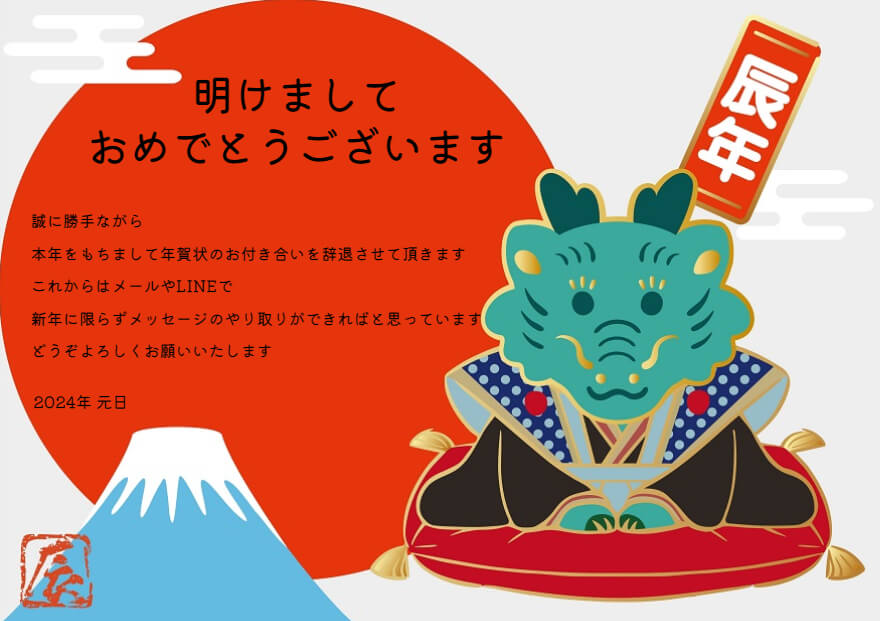
There are also cases where you cannot keep sending Nengajō, in which case you need to notify your acquaintance to avoid being rude.
If he/ she is someone you can meet or message, notify them before December, ideally before they prepare to send out Nengajō.
Or you can also use Nengajō this year instead of announcements.
Below is a sample paragraph when you want to stop sending Nengajō.
明けましておめでとうございます
誠に勝手ながら
本年をもちまして年賀状のお付き合いを辞退させて頂きます
これからはメールやLINEで
新年に限らずメッセージのやり取りができればと思っています
どうぞよろしくお願いいたします
2024年 元日
Meaning:
Happy New Year!
Regrettably, I will be discontinuing the tradition of exchanging New Year’s cards as of this year.
Moving forward, I hope we can communicate through email or LINE, not limited to the New Year.
Thank you for your understanding.
January 1, 2024
Conclusion
Nengajō not only represents New Year’s greetings but also shows gratitude for the care your partner has given you in the past year.
So, with anyone you cherish and want to maintain a long-term relationship with, you can send Nengajō to them.
To express your sincerity and avoid being rude, follow the prescribed writing style by writing the recipient and sender information vertically on the front, and writing a greeting on the back.
And don’t forget to send Nengajō before December 25 to ensure the other person receives Nengajō on January 1, starting a wonderful new year!

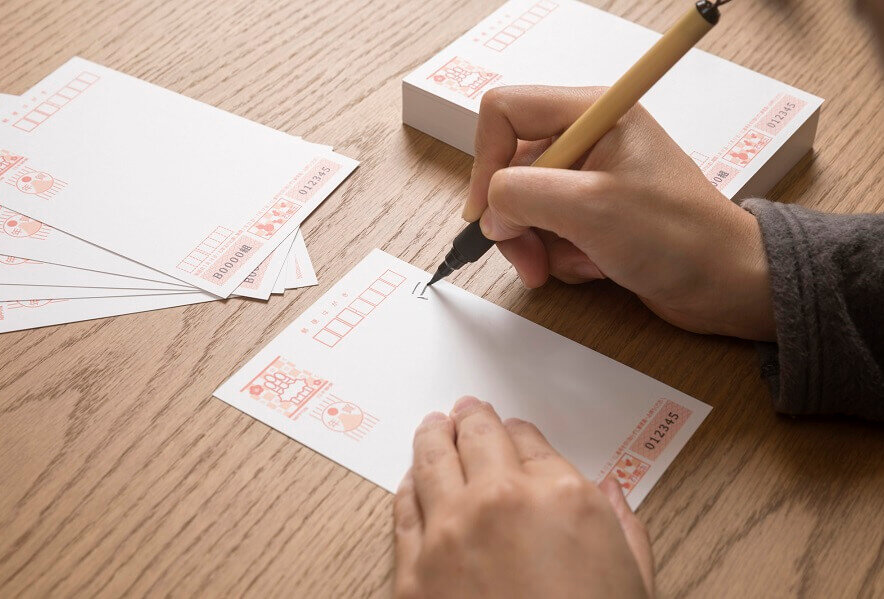
Comment